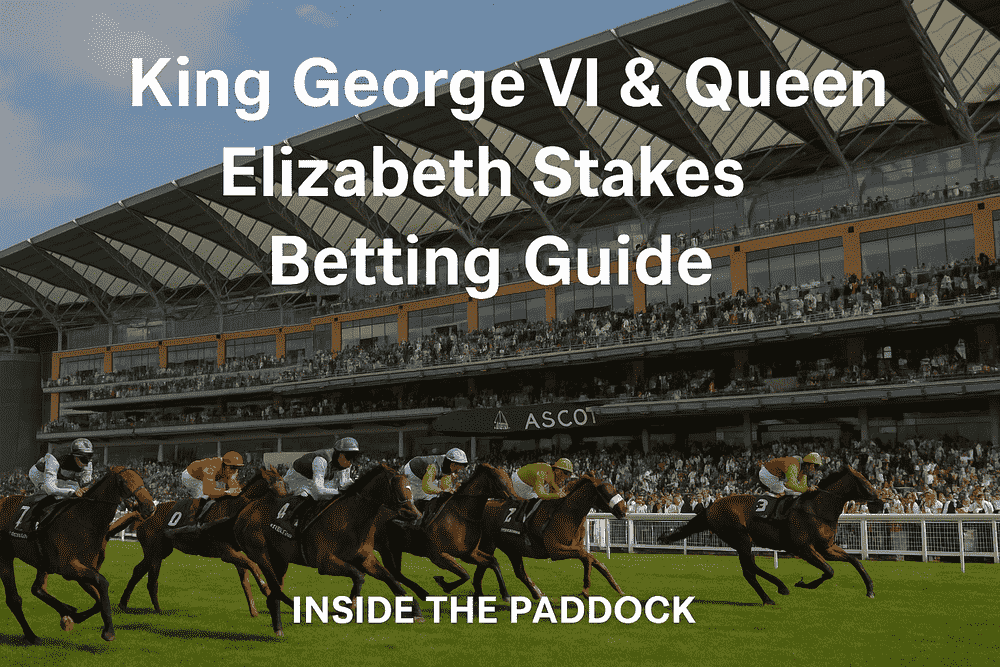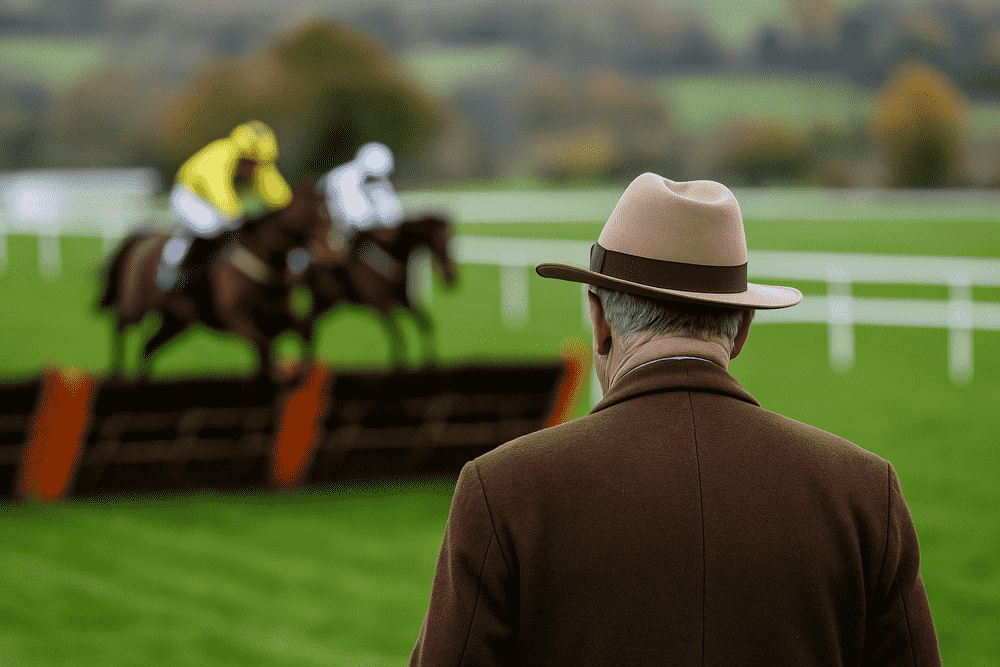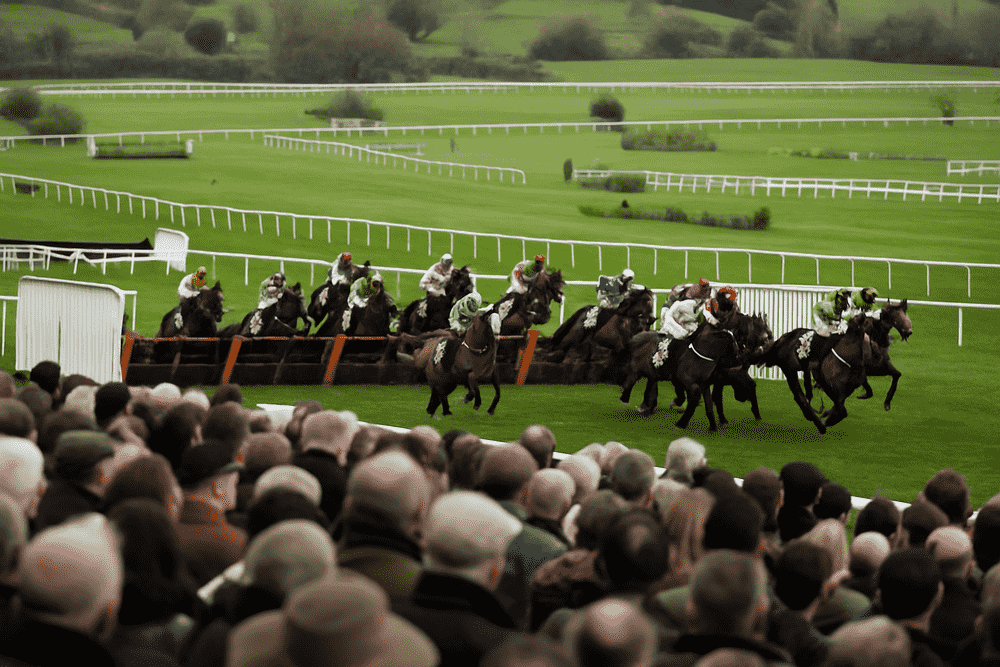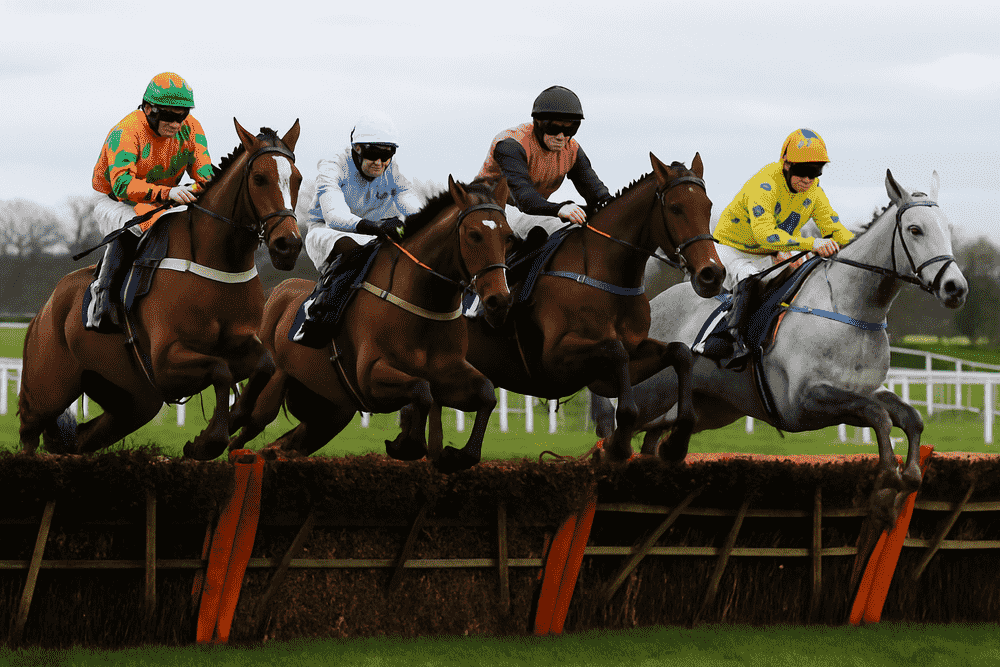If horse racing had a “royal summit,” it would be the King George VI and Queen Elizabeth Stakes betting guide 2025. The King George VI & Queen Elizabeth Stakes, usually just called the King George, is Ascot’s midsummer race, staging one of the most dramatic battles in the sport. It’s twelve furlongs of pure tension: three-year-olds fresh from the Derby taking on seasoned older champions, with reputations and millions on the line.
So whether you’re a bettor, a fan of racing history, or just someone who enjoys a good clash of titans, this guide is here to walk you through everything you need to know. From the origins of the race to the stats that matter, plus betting angles that could help you make smarter picks next time around.
- What is the King George?
- History
- Legendary winners
- Recent winners
- Past winners
- Records
- Why it matters
- Betting trends
- Race tactics
- How to watch
- Modern relevance
- FAQs
What is the King George VI & Queen Elizabeth Stakes at Ascot?
Held every late July at Ascot Racecourse, the King George VI and Queen Elizabeth Stakes betting guide 2025 highlights this Group 1 flat race run over a testing 1 mile and 4 furlongs (2400m). It’s not just another date on the calendar—it’s the ultimate midsummer test.
What makes it special? It’s the first major opportunity for the best three-year-olds, fresh from their Derby campaigns, to face off against elite older horses. This clash of generations is what gives the race its edge. Win here, and a horse isn’t just a promising youngster or a solid veteran—they’re stamped as a genuine great.
History of the King George VI & Queen Elizabeth Stakes
As explained in this King George VI and Queen Elizabeth Stakes betting guide 2025, the race was created in 1951 when British racing didn’t really have a midsummer championship over a mile and a half. The idea was simple but bold: bring the very best middle-distance horses—three-year-olds fresh from the Classics and tough older campaigners—into one definitive showdown at Ascot. The royal connection gave it instant prestige; the quality of winners since has done the rest.
From the early runnings it was clear this wasn’t just another nice date on the social calendar. The King George became a truth-serum race: if you were a Derby hero, this was where you proved it wasn’t just the Epsom camber working in your favour; if you were an older ace, this was the stage to swat away the “new kids” and keep your crown. The concept caught on so fast because it solved a real sporting itch—fans and trainers wanted a clean, generation-clash marker in the middle of the season. Ascot provided the theatre.
Across the decades the roll of honour has looked suspiciously like a Hall of Fame. In the 1980s you had Shergar’s demolition job and Dancing Brave’s turbocharged turn of foot. The turn of the millennium delivered powerhouse Europeans like Montjeu and Galileo, both stamping themselves as the benchmark for class and stamina. In the modern era, Enable turned the race into her personal summer home, returning year after year to remind everyone how a top-class 12-furlong mare should do it. Different eras, same theme: champions meet, reputations are made (or unmade) in just over two minutes.
What really cements the King George’s status is how often it points to the rest of the season. Because it’s run over the same trip as the Prix de l’Arc de Triomphe and attracts a truly international field, the form tends to travel. Trainers use Ascot as both a target in its own right and a measuring stick for autumn. Win here, and you’re not just “in the conversation” for Paris—you’re suddenly the one everyone else has to beat.
There’s also a cultural side to it. Royal Ascot in June is the sport’s big society week; the King George, a few weeks later, is more spartan in tone—less hats, more horsepower. It’s the day the marketing gloss gets peeled back and the best horses actually sort it out on the grass. That dynamic has helped the race keep its bite: it feels like a proper championship, not a fashion parade.
Put simply, the King George exists to answer awkward questions with hard evidence. Can a brilliant three-year-old handle battle-hardened rivals? Can a public favourite give weight and still dominate? Each summer, Ascot asks—and the King George answers.
Legendary King George winners and iconic moments
The King George isn’t just another line on a horse’s CV—it’s where reputations are made, legends are confirmed, and sometimes careers are broken. Flick through its history and you’ll find a highlight reel of racing that fans still talk about decades later.
- Shergar (1981) – Already a household name after destroying the Derby, Shergar made the King George look like a training gallop. He powered away by four lengths with his ears pricked, so dominant that bookmakers considered refusing bets on him in future races. It was a performance that confirmed him as a once-in-a-generation talent.
- Dancing Brave (1986) – Few horses have thrilled fans like Dancing Brave. In the King George he produced a withering late burst, mowing down rivals in the final furlong. Commentators called it one of the most electrifying finishes in modern racing. He would later go on to win the Arc, completing the summer-autumn double that many dream of but few achieve.
- Lammtarra (1995) – A colt with the weight of expectation on his back, Lammtarra had already won the Derby. At Ascot, he delivered again, proving his class wasn’t a fluke and extending his unbeaten record. His story—brief but brilliant—still captures imaginations.
- Montjeu (2000) – The French champion stormed through the Ascot straight as if the others were standing still. His acceleration was jaw-dropping, leaving multiple Group 1 winners floundering behind. Watching Montjeu at full stretch was like watching a predator chase its prey.
- Galileo (2001) – Now better known as perhaps the most influential sire of the modern era, Galileo stamped his authority on the King George as a three-year-old. It was a performance of grit and class, setting the tone for a career that would shape bloodlines for decades.
- Harbinger (2010) – If you want “wow factor,” look no further. Harbinger’s 11-length demolition of the field remains one of the most jaw-dropping spectacles in Flat racing. The winning margin was so wide that handicappers scrambled to adjust ratings, eventually awarding him one of the highest ever. For many, it was the most dominant King George performance ever.
- Enable (2017, 2019, 2020) – The Queen of Ascot. Enable didn’t just win—she kept coming back. Her three King George victories made her a folk hero and underlined her stamina, consistency, and class. Watching Frankie Dettori punch the air on her back became one of the enduring images of 21st-century racing.
The magic of the King George lies in this: it’s not just about winning, it’s about how you win. Some horses dominate, some fight tooth-and-nail, some flash brilliance in a heartbeat. But every year, the race finds a way to produce a story.
Recent King George Ascot winners
The 2025 renewal saw Calandagan storm home to victory, seeing off a strong field that included Kalpana. The tactics were smart, the pace was steady early, and when the sprint came, Calandagan had the gears to finish best of all.
It was also the richest edition of the race ever, with King George prize money hitting £1.5 million—underlining its status as not just a sporting highlight but a financial powerhouse in the racing world.

Past King George VI & Queen Elizabeth Stakes winners
Here’s a look at some of the standout winners from the last decade, plus a reminder of the legends that came before:
| Year | Winner | Age | Jockey | Trainer |
|---|---|---|---|---|
| 2025 | Calandagan | 4 | Mickaël Barzalona | Francis-Henri Graffard |
| 2024 | Goliath | 4 | Christophe Soumillon | Francis-Henri Graffard |
| 2023 | Hukum | 6 | Jim Crowley | Owen Burrows |
| 2022 | Pyledriver | 5 | P. J. McDonald | William Muir & Chris Grassick |
| 2021 | Adayar | 3 | William Buick | Charlie Appleby |
| 2020 | Enable | 6 | Frankie Dettori | John Gosden |
| 2019 | Enable | 5 | Frankie Dettori | John Gosden |
| 2018 | Poet’s Word | 5 | James Doyle | Sir Michael Stoute |
| 2017 | Enable | 3 | Frankie Dettori | John Gosden |
| 2016 | Highland Reel | 4 | Ryan Moore | Aidan O’Brien |
And if we go further back, you’ll see names like Montjeu, Galileo, Daylami, Nashwan, Lammtarra—the sort of horses that changed breeding and racing history.
These King George Ascot winners are more than names on a roll of honour—they are milestones in racing history. You can explore the full list of past winners and results on the Racing Post archive
King George racing records and standout figures
Most successful horse: Enable (3 wins – 2017, 2019, 2020)
These King George racing records underline why the race has become a benchmark for greatness in flat racing.
Most successful jockey: Lester Piggott and Frankie Dettori, both multiple-time winners
Most successful trainer: Sir Michael Stoute, who has trained a record number of King George winners
Notable stat: Many King George winners have gone on to land the Prix de l’Arc de Triomphe later the same season, making it the perfect stepping stone to autumn glory.
Why the King George VI & Queen Elizabeth Stakes matters
The King George is more than just a race—it’s a measuring stick for greatness.
- For three-year-olds, it’s the chance to prove Derby form wasn’t a fluke. In fact, Derby winners in the King George—like Galileo and Adayar—have often confirmed their brilliance at Ascot.
- For older stars, it’s a chance to crush youthful pretenders and cement dominance.
- For fans and bettors, it’s often the most reliable form guide heading into the Prix de l’Arc de Triomphe.
In other words, the King George isn’t just about midsummer glory—it shapes the entire second half of the European racing calendar.
If you enjoy midsummer clashes like the King George, you might also want to check our Coral-Eclipse betting guide, which covers Sandown’s other great generation-defining race.

King George betting trends and key stats
For punters, this King George VI and Queen Elizabeth Stakes betting guide 2025 shows why the race is a minefield—half the field are already Group 1 winners, the rest are potential superstars. But history leaves clues, and if you dig into the data, some clear patterns emerge.
King George age and experience trends
The three-year-olds often steal the headlines. Horses like Galileo (2001), Adayar (2021) and Westover (2022) all won fresh off Derby campaigns. The weight-for-age allowance gives them a vital edge: they carry less than their older rivals, making it easier to last the 12 furlongs at a relentless pace.
That said, older horses shouldn’t be ignored. Enable won as a 3yo, a 5yo, and a 6yo. Hukum (2024) and Pyledriver (2023) showed that tough, battle-hardened veterans can turn back the clock when they’re fit and firing. So while youth often edges it, class and conditioning still count.
King George recent form and sharpness
Look at the stats: in the last 15 runnings, almost every winner had finished first or second in a Group race on their most recent start. This is not a race where you can “come in cold.” Trainers target it with horses already in peak condition.
In fact, horses that ran at Royal Ascot in June—especially in the Prince of Wales’s Stakes or the Hardwicke—have an excellent record. That Ascot experience is gold dust, because they already know the track and arrive race-fit.
King George ratings and class levels
This is not the place for an improver to suddenly make a giant leap. Most winners come in with an official rating of 120+. In other words: these are proven elite performers.
When you see a horse that has been dominating Group 2s, ask yourself: can they step up in grade? The King George punishes pretenders. Only genuine Group 1 talent survives the Ascot test.
King George trainers and jockey records
Certain names keep popping up.
- Sir Michael Stoute has mastered the art of peaking his horses for this exact contest, sending out multiple winners across four decades.
- Aidan O’Brien and his Ballydoyle juggernaut are ever-present threats—Highland Reel, Galileo, and plenty more bear his stamp.
- John Gosden used Enable to show his mastery of preparing fillies and mares for battles with the colts.
And then there are the jockeys. Frankie Dettori and Lester Piggott are synonymous with the King George. When punters see Dettori’s name on the racecard at Ascot, history tells them to take notice.
King George betting markets and punters’ angles
The King George isn’t one of those chaotic handicaps where 20/1 shots come flying in. King George betting odds usually reflect the class on display, and favourites actually have a solid record. Horses like Enable, Galileo, and Montjeu all started at short odds—and justified the faith.
But here’s where value hides: each-way bets on seasoned older horses. Pyledriver in 2023, priced bigger than the flashy three-year-olds, rewarded those who trusted his grit and course record. In fact, older horses placed in the top three at very decent odds more often than casual punters realise.
And finally: late market moves matter. In recent years, horses that shortened significantly in the final 30 minutes before the off ran to form far more often than not. When the smart money speaks, it’s usually worth listening.

King George race tactics and Ascot course insight
Ascot’s 12-furlong course is a proper examination—no hiding places, no soft landings. If the Epsom Derby is a rollercoaster with cambers and undulations, Ascot is a more straightforward track on paper. But don’t let that fool you: the King George regularly chews up hot favourites who underestimate its rhythm.
Shape of a King George race
The first half of the King George is often a balancing act. Jockeys know they need to save energy for the punishing final furlong, but if the early pace is too slow, the race can turn into a messy sprint. That’s why we often see pacemakers, particularly from the big stables like Ballydoyle. Their job isn’t to win—it’s to guarantee a solid gallop that suits their stablemate.
For bettors, spotting these tactical plays is crucial. A horse who looks outpaced early may actually be waiting for the pacemaker to do its job. When the tempo lifts in the final half-mile, the true stayers come alive.
Ascot uphill finish in the King George
The last furlong at Ascot climbs steadily, and it’s where races are won and lost. Horses that travel keenly and burn petrol early often fade dramatically in the closing stages. Meanwhile, those that relax, find a rhythm, and conserve fuel often power home.
Think of Enable’s 2017 victory—she sat handy, never over-raced, and when Dettori pressed the button two furlongs out, she surged clear up the hill with authority. Compare that to horses who pull too hard early; they look like world-beaters at the half-mile pole, then stagger like tired sprinters as the ground rises.
Stamina in King George winners
This isn’t a race for speed merchants trying to stretch out. Horses that thrive at 10 furlongs but haven’t proven themselves at 12 often get found out. The King George asks the stamina question every single year, and only genuine stayers answer it.
Look at Highland Reel (2016)—not flashy, but tough as nails. He controlled the tempo, wound it up gradually, and simply outstayed his rivals. That’s textbook King George riding: patience early, strength late.
Tactics: positioning and patience at the King George
Where you sit in the field can be the difference between glory and defeat. On good ground, being handy is an advantage; you avoid traffic and can press early if needed. On softer ground, waiting tactics sometimes work best, as rivals tire in the slog up the straight.
The key? Balance. Too far back and you’re praying for a miracle run. Too close to the pace and you risk burning out before the line. The very best King George-winning rides manage that knife-edge perfectly.
Common King George race patterns
- Solid gallop, relentless finish – suits strong stayers like Highland Reel.
- Steady pace, late dash – produces dramatic sprints where turn of foot rules, like Dancing Brave.
- Attritional tests on soft ground – favour grinders who keep finding, even if it’s not pretty.
For punters, recognising what kind of race shape is likely—based on ground, entries, and pacemakers—can give you the crucial edge.
How to watch and bet on the King George at Ascot
Watching the race
If you’re in the UK, the King George is broadcast live on ITV Racing and also available on Racing TV. Bookmakers’ platforms also stream it for account holders. International fans can usually find coverage through local racing networks.
Betting markets
Typical options include:
- Win betting – picking the outright winner
- Each-way betting – always attractive in such high-class fields
- Forecasts and tricasts – predicting the exact order (for the brave only)
- Special markets – such as “Will the Derby winner do the double?”
Betting angles
- Don’t dismiss the three-year-olds, especially if they’re proven at the Derby trip.
- Proven stamina is as important as speed—Ascot’s uphill finish punishes the flashy but fragile types.
- Each-way bets on top-class older horses often provide the best value.
Modern relevance of the King George VI & Queen Elizabeth Stakes
The King George isn’t just a glittering summer prize—it’s a race that shapes the rest of the season and even the sport itself. Every July, the Ascot showdown answers burning questions and points directly towards bigger targets in the autumn.
A stepping stone to the Arc
If you’re trying to predict the Prix de l’Arc de Triomphe, the King George is one of the most important clues. Both races are run over 12 furlongs, both attract international fields, and both demand a mix of stamina, class, and tactical brilliance.
Many King George champions have gone on to win the Prix de l’Arc de Triomphe, confirming Ascot’s race as the perfect midsummer trial for Paris.
Horses like Dancing Brave, Montjeu, and Enable all used King George wins as a springboard to Arc glory. Bettors know that a dominant Ascot performance in July often translates into Paris success in October. In fact, the King George is sometimes jokingly called “the Arc trial that isn’t labelled as one.”
A true clash of generations
Plenty of races pit three-year-olds against older rivals, but few do it as dramatically as the King George. The Derby hero arrives at Ascot with a question mark: was Epsom brilliance real, or just one dazzling day? The older champions show up to answer it.
That dynamic—youthful ambition vs. seasoned strength—gives the King George its edge. For fans, it feels like sport at its purest: the best of one generation against the proven champions of another.
Breeding implications
Winning the King George doesn’t just earn prize money and prestige—it transforms a horse’s future. For colts, a King George victory can send their stud value skyrocketing. Breeders love a proven 12-furlong champion because it guarantees stamina, durability, and class in the bloodline.
Just look at Galileo: his King George win in 2001 confirmed him as a superstar, and his subsequent career at stud changed the breed itself. Many modern winners trace back to him, directly or indirectly. The King George is a race that reshapes pedigrees, not just racing seasons.
Calendar importance
The King George acts as a midsummer championship. Royal Ascot in June is glamorous, but it’s split into sprints, milers, and stayers. The Derby is huge, but restricted to three-year-olds. The Arc is autumn’s big stage, but it comes late in the season.
The King George fills the gap. It is the one moment in July where everyone stops and says: “This is the race that tells us who really is the best middle-distance horse in training.”
Cultural significance
There’s also something uniquely British about it. Unlike the fashion parade of Royal Ascot, the King George is all business. Less champagne, more horsepower. It’s a day for racing purists—an event where the sport speaks louder than the society pages.
And because of that, it endures. Every generation has its King George hero, and each one adds a new layer to the race’s mythology. Whether you’re in the grandstand at Ascot or watching from your sofa, you know you’re tuning into more than a race—you’re witnessing a midsummer tradition that defines greatness.

FAQs: King George VI & Queen Elizabeth Stakes betting guide
When is the King George run each year?
It’s held in late July at Ascot Racecourse.
What distance is the race run over?
1 mile and 4 furlongs (2400 metres).
Who is the most successful horse in the race?
Enable, with three wins (2017, 2019, 2020).
Which trainer has the most wins?
Sir Michael Stoute, who has built an extraordinary record in the race.
Who won the 2025 King George?
Calandagan, ridden by Christophe Soumillon and trained by Jean-Claude Rouget.
Why is the race so important?
Because it brings together the best of both generations and acts as a key stepping stone to the Prix de l’Arc de Triomphe.
Has a Derby winner ever won the King George?
Yes. Several Derby champions have gone on to add the King George at Ascot. Famous examples include Galileo (2001) and Adayar (2021), both of whom confirmed their class by beating older horses over the same trip.
What is the prize money for the King George?
In 2025, King George prize money reached £1.5 million, making it one of the richest races in Europe over 12 furlongs. The winner alone takes home a seven-figure cheque.
Which King George winners went on to win the Arc?
Many legends have done the famous double: Dancing Brave (1986), Montjeu (2000) and Enable (2017) all won both the King George at Ascot and the Prix de l’Arc de Triomphe in Paris.
Who is the most successful trainer in the King George?
Sir Michael Stoute holds the record with multiple wins, training champions across four decades. His strike rate at Ascot makes him one of the most feared names in this midsummer showdown.
Final thoughts on the King George VI & Queen Elizabeth Stakes
The King George VI and Queen Elizabeth Stakes betting guide 2025 proves that this Ascot midsummer jewel isn’t just another race—it’s one of the most prestigious in the world. With a roll of honour full of champions, betting angles shaped by decades of trends, and a direct link to autumn’s biggest races, it’s the kind of event that defines careers.
If you’ve enjoyed this guide, make sure to check out more of our Betting Guides, including our deep dives into the Coral-Eclipse, the Epsom Derby, and other iconic races.













Epsom Derby Betting Guide 2025 | history, winners & key trends –
[…] King George VI & Queen Elizabeth Stakes at Ascot is another crucial midsummer pointer to the […]